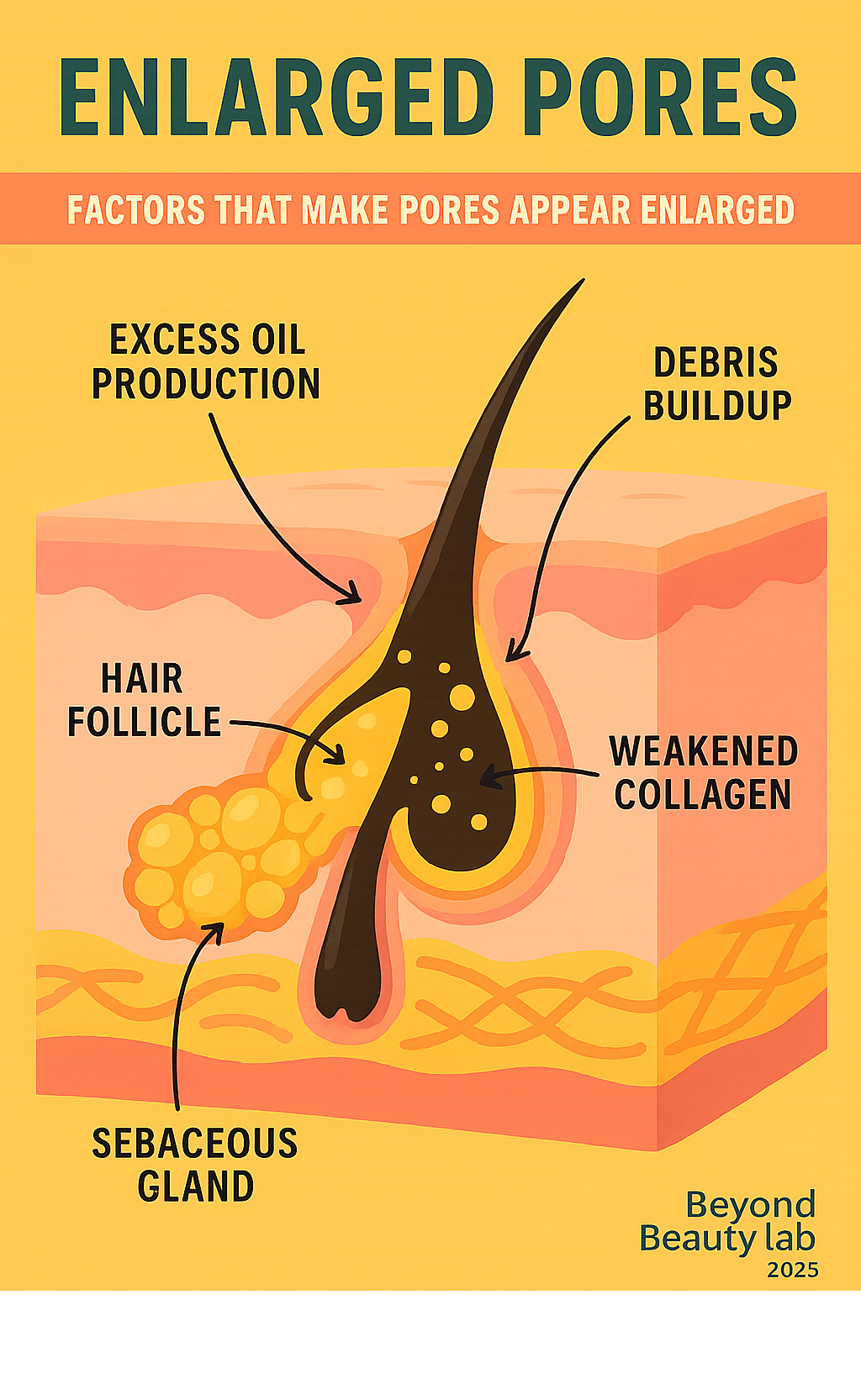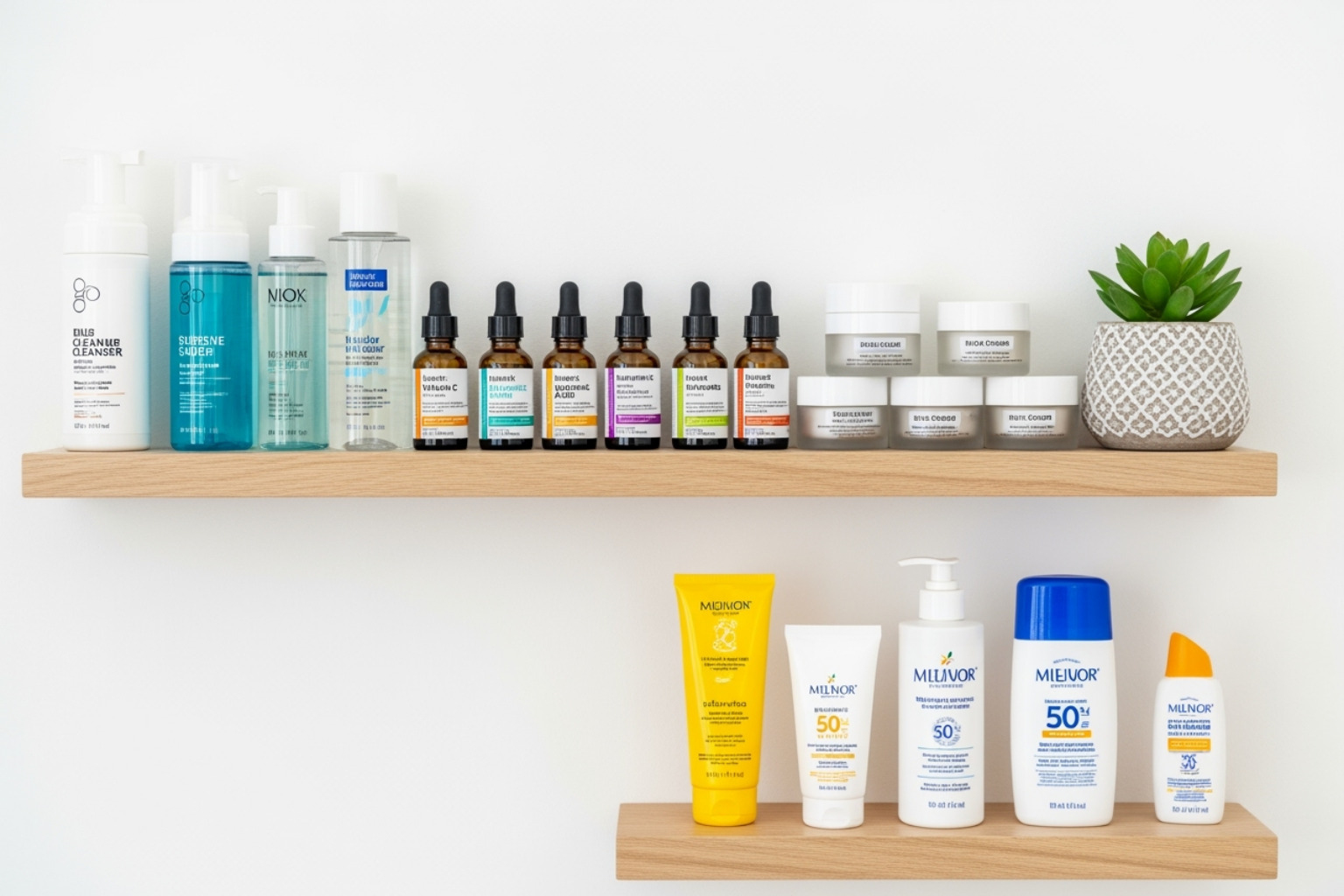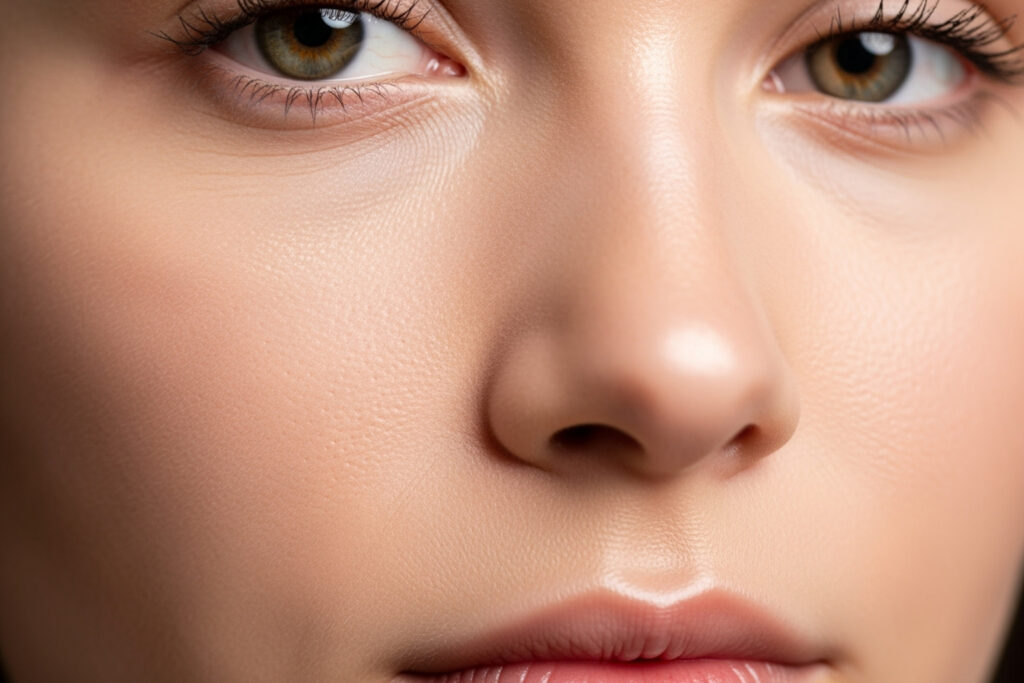Why Finding the Best Treatment for Shrinking Pores Matters for Your Skin Health
The best treatment for shrinking pores combines consistent at-home care with professional treatments when needed. Here’s what actually works:
Top At-Home Treatments:
- Salicylic acid (BHA) for oil control and pore clearing
- Retinol for collagen stimulation and cell turnover
- Daily sunscreen to prevent collagen breakdown
- Clay masks weekly to absorb excess oil
Most Effective Professional Treatments:
- RF Microneedling (results in 1-3 weeks, lasting months)
- Chemical peels with glycolic or salicylic acid
- Fractional CO2 lasers for long-term collagen building
- HydraFacial for immediate pore clearing (under 30 minutes)
Those tiny openings you see in the mirror are pores, and they’re essential for releasing oil and sweat to keep your skin healthy. While you can’t permanently shrink your pores – their size is mostly genetic – you can make them appear smaller by keeping them clear and supporting the surrounding collagen.
The average adult has around 20,000 pores on their face. Some appear larger due to oil buildup, sun damage that weakens collagen, or genetics. The good news is that both at-home and professional treatments can dramatically improve how your pores look.
Effective pore treatment combines daily habits with professional procedures for faster, longer-lasting results.

Basic best treatment for shrinking pores vocab:
Understanding Enlarged Pores: What’s Really Happening?
Your pores don’t open and close; they’re fixed openings whose size is largely determined by your DNA. If your parents had prominent pores, you likely inherited that trait too.
But genetics aren’t the whole story. Several factors make pores appear larger, which is why finding the best treatment for shrinking pores requires understanding the cause.
Sebum production is a major factor. Your pores connect to oil glands that produce sebum to protect your skin. When these glands are overactive, the excess oil mixes with dead skin cells, clogging the pore. When a pore gets clogged, it stretches, making it more visible. This is why people with oily skin often notice their pores more, especially in the T-zone.
Aging also plays a role. As we get older, our skin loses collagen and elastin – the proteins that keep it firm. When this protein scaffolding weakens, the skin around your pores sags, making them look larger.
Sun damage dramatically accelerates this process. UV rays break down collagen and elastin, which is why sun protection is essential for maintaining smooth-looking skin.
Clogged pores and hormonal changes can worsen pore appearance. When hormones fluctuate, oil production can spike, leading to more clogs. These clogs can stretch the pore walls, leaving them looking wider even after being cleared.
While you can’t change your genetics, you can address these other factors. Understanding the cause of your pore concerns is the foundation for choosing an effective treatment. Scientific research on pore causes continues to reveal new insights.
For those dealing with excess oil, our guide on oily skin pores offers targeted strategies.
The Role of Lifestyle and Diet
Your lifestyle and diet play a supporting role in how your pores look. Think of it as the foundation for your skincare routine.
Hydration is crucial. When your skin lacks water, it can compensate by producing more oil, leading to more clogged pores. Drinking plenty of water helps maintain your skin’s natural balance.
What you eat also matters. Foods rich in antioxidants – like colorful fruits and leafy vegetables – help fight inflammation and protect skin cells.
On the other hand, high-glycemic foods like refined sugars and processed snacks can cause blood sugar spikes, triggering hormonal shifts that increase oil production and make pores more noticeable.
A balanced diet rich in omega-3 fatty acids, vitamins, and minerals creates the ideal internal environment for healthy skin. While diet won’t magically transform your pores, it supports the effectiveness of any best treatment for shrinking pores you choose.
For more natural approaches, explore our collection of natural beauty remedies that complement your pore-minimizing efforts.
Your At-Home Arsenal: Daily Practices to Minimize Pores

The best treatment for shrinking pores often starts in your bathroom with smart, consistent daily habits.
A consistent routine is everything for pore care. Your skin thrives on predictability, so skipping days or constantly switching products can lead to frustrating results.
Gentle cleansing twice daily is your foundation. Use warm (not hot!) water and a non-comedogenic cleanser. Hot water strips your skin and can make pores look more prominent.
If you wear makeup or sunscreen, the double cleansing method is a game-changer. Start with an oil-based cleanser to dissolve buildup, then follow with a water-based cleanser. This two-step process ensures no residue is left to clog pores.
Exfoliation is key but easy to overdo. The goal is to gently remove dead skin cells that clog pores. Chemical exfoliants like AHAs and BHAs are often gentler than physical scrubs. Start with once or twice a week to see how your skin responds.
For those with oily skin and enlarged pores, our Skincare Routine for Oily Skin with Large Pores breaks down how to put these practices together.
Key Ingredients: The Best At-Home Treatment for Shrinking Pores
The right ingredients can transform your routine into a powerful pore-minimizing system.
Salicylic Acid (BHA) is an oil-soluble exfoliant that deep-cleans pores by dissolving the mixture of dead skin cells and sebum. Its anti-inflammatory properties also help calm irritated skin.
Glycolic Acid (AHA) is a water-soluble acid that works on the skin’s surface, dissolving dead skin cells for a smoother, brighter texture and less congested pores.
Retinoids (Retinol) are a long-term investment. They speed up cell turnover to prevent clogs and stimulate collagen production, which firms the skin around pores, making them appear tighter over time.
Niacinamide (Vitamin B3) helps regulate oil production, so pores are less likely to become overwhelmed. It also reduces inflammation and improves skin elasticity for a more refined appearance.
Clay and Charcoal masks, used weekly, absorb impurities and excess oil, temporarily making pores appear smaller by clearing them out.
These ingredients work best as part of a comprehensive approach. Our guide to the Best Skincare Routine for Blackheads and Oily Skin shows you how to combine them for maximum impact.
The Non-Negotiable Steps: Sun Protection and Moisturization
Skipping sunscreen and moisturizer can sabotage your efforts to minimize pores.
Daily SPF is non-negotiable, as sun damage is a primary cause of enlarged pores. UV rays break down the collagen and elastin that keep pores tight. Apply broad-spectrum SPF 30 or higher every day.
When choosing non-comedogenic sunscreen, look for labels like “oil-free” or “won’t clog pores.” Our guide to the Best Sunscreens for Oily and Acne-Prone Skin can help you find the right one.
A common myth is that oily skin doesn’t need moisturizer. In reality, dehydrated oily skin often produces even more oil to compensate, which can clog pores. A lightweight, non-comedogenic moisturizer maintains balance without adding grease.
Our Lightweight Moisturizer for Oily Acne-Prone Skin guide helps you find formulas that hydrate without heaviness.
The best treatment for shrinking pores at home combines consistent cleansing, active ingredients, sun protection, and proper hydration.
The Professional Edge: The Best Treatment for Shrinking Pores In-Office

When at-home care isn’t enough, in-office procedures can deliver the dramatic, long-lasting results that daily skincare can’t match. Professional treatments work beneath the surface, stimulating your skin to rebuild itself by triggering collagen production and resurfacing damaged skin. They address the root causes of enlarged pores, not just the symptoms.
A consultation with a qualified dermatologist is crucial. They will assess your skin, discuss realistic expectations, and recommend the best treatment for you. This personalized approach is key.
For targeted concerns like stubborn cheek pores, professional guidance is invaluable. Our guide on How to Tighten Pores on Cheeks explores these challenges in detail.
Comparing In-Office Pore Treatments
Choosing the right professional treatment is essential. Here’s how the top contenders stack up:
Microneedling
- Effectiveness for Pores: Stimulates collagen, strengthening supportive structure around pores, making them appear smaller. Addresses texture, fine lines.
- Downtime: Minimal (redness, swelling resembling sunburn for 1-3 days).
- Cost (Approximate): $200 – $800 per session.
- Best Candidates: Most skin types, those with texture issues, mild scarring, and fine lines.
Chemical Peels
- Effectiveness for Pores: Removes dead skin cells, unclogs pores, stimulates collagen. Deep-cleans pores.
- Downtime: Varies by peel depth (mild redness/flaking for days, deeper peels require more).
- Cost (Approximate): $100 – $600 per session.
- Best Candidates: Oily, acne-prone, congested skin, uneven tone, fine lines.
Laser Therapy
- Effectiveness for Pores: Resurfaces skin, stimulates collagen/elastin, tightens skin, reduces pore size.
- Downtime: Varies by laser type (minimal to several days of redness/swelling/peeling).
- Cost (Approximate): $300 – $2500+ per session.
- Best Candidates: Those seeking significant texture improvement, addressing acne scars, fine lines, and sun damage.
Microneedling creates tiny, controlled injuries to stimulate collagen production. This strengthens the skin around pores, making them appear tighter.
Chemical peels remove the top layers of skin, unclogging pores and encouraging new cell growth. Peel depth determines results and recovery time.
Laser therapy uses light energy to resurface skin and stimulate collagen. Different lasers offer varying intensities and results.
Laser Therapy and Microneedling: The Best Treatment for Shrinking Pores with Lasting Results
RF microneedling and fractional lasers deliver results that last for months, making them a long-term investment in your skin’s health.
RF microneedling combines traditional microneedling with radiofrequency energy. This duo triggers an impressive healing response that builds new collagen and elastin. Initial improvements appear in one to three weeks, with full results developing over several months as new collagen forms. Downtime is minimal, usually 1-3 days of mild, sunburn-like redness.
Fractional CO2 lasers create microscopic columns of treated tissue surrounded by healthy skin, allowing for faster healing while still triggering significant collagen remodeling. These lasers excel at improving overall skin texture, which makes pores appear smaller. Other options like Clear and Brilliant offer gentler resurfacing with less downtime.
The number of sessions varies, but most people need 3-6 treatments spaced several weeks apart for optimal results.
Potential side effects are generally mild and temporary, including redness, swelling, and peeling. Serious complications are rare when treatments are performed by qualified professionals.
When to See a Dermatologist
Here are signs it’s time to see a professional.
Persistent concerns are a key indicator. If you’ve been diligent with your skincare for three to six months without seeing desired improvements, it’s time for professional help.
Acne-related pore issues often require prescription-strength solutions. A dermatologist can prescribe medications like tretinoin or oral treatments that work from the inside out.
Exploring prescription options and advanced procedures requires a licensed professional.
Finding a qualified professional is crucial for safety and results. A board-certified dermatologist has the training to properly assess your skin and recommend the best treatment for shrinking pores for you. You can Find a board-certified dermatologist through the AAD directory.
Frequently Asked Questions about Shrinking Pores
Let’s tackle some of the most common questions about the best treatment for shrinking pores.
Can you permanently shrink your pores?
The truth is, you cannot permanently shrink your pores. Understanding this helps set realistic expectations. Your pore size is largely determined by your genetics. However, you can absolutely minimize their visibility.
The role of collagen is huge. Strong collagen support around each pore makes them look tighter. As collagen weakens with age or sun damage, pores can look more prominent. This is why collagen-boosting treatments make such a difference.
Long-term maintenance through consistent skincare and occasional professional treatments is key to keeping pores looking refined.
How long does it take to see results from pore treatments?
The time it takes to see results varies by treatment, and patience is required.
For at-home treatments using ingredients like salicylic acid or retinoids, you may feel smoother skin in a few weeks, but visible changes in pore appearance can take 2-3 months of consistent use.
Professional treatments work much faster. A HydraFacial offers immediate smoothness. RF Microneedling typically shows results within one to three weeks, with improvements continuing for months. Chemical peels may require a series for full benefits, while laser treatments show initial improvement within a week, with final results developing over the following months.
Consistency is key for any treatment plan to be successful.
Are pore vacuums and extraction tools safe to use at home?
While tempting, at-home pore vacuums and extraction tools come with significant risks.
The risks of damage include bruising, broken capillaries, and irritation. Overuse or improper technique can cause more harm than good.
There is also a potential for scarring. Aggressive squeezing or improper tool use can push bacteria deeper, causing inflammation, breakouts, and even permanent pitted scars.
Professional extraction is safer. Dermatologists and licensed estheticians use proper techniques and sterile conditions to clear pores effectively without damaging your skin. It’s best to seek professional help for extractions.
Conclusion: Crafting Your Path to Smoother Skin
Pores are not flaws to be eliminated; they are essential for healthy skin. The goal isn’t to make them disappear – which is impossible – but to make them appear refined and less noticeable.
The best treatment for shrinking pores isn’t a single miracle solution but a thoughtful strategy custom to your skin. While genetics determine pore size, your routine determines their appearance.
Build a strong foundation with your daily at-home routine. Gentle cleansing, ingredients like salicylic acid and retinoids, and non-negotiable daily sunscreen and moisturization are your skin’s best defense against factors that enlarge pores.
When you need a boost, professional treatments like RF microneedling, lasers, and chemical peels can provide an extra edge by stimulating your skin’s natural healing processes for tighter, smoother-looking skin.
Patience and consistency are your best friends on this journey. Results take time, from a few weeks to a few months, and this is completely normal.
At Beyond Beauty Lab, we believe that education is the foundation of beautiful skin. When you understand how ingredients and treatments work, you can make informed decisions that lead to real improvements.
Your path to smoother skin is unique. What matters is taking consistent, knowledgeable steps toward your goals with realistic expectations.
Ready to put this knowledge into action? Explore our recommended skincare products to find gentle, effective options that support your journey toward healthier, more radiant skin. Your future self will thank you for starting today.








